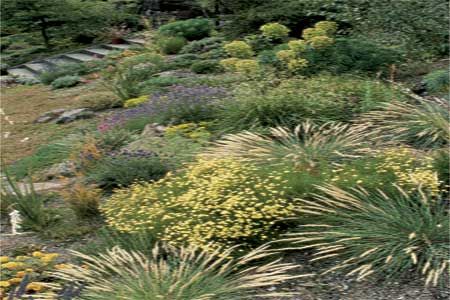We may be compensated if you purchase through links on our website. Our team is committed to delivering honest, objective, and independent reviews on home products and services.
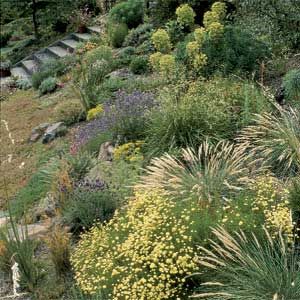
Ornamental grasses are the eye-catching cousins of traditional turf grass, offering a natural and dynamic element to any landscape. Besides being beautiful, ornamental grasses serve many uses in the garden. They can fill flower beds, block out bad views, or even be the main focus of your yard.
Making Grass Choices
Ornamental grasses come in several colors, heights, and textures, ranging from less than 12 inches to over 10 feet tall. With their low maintenance and resistance to pests and diseases, ornamental grasses are popular among homeowners and landscapers alike. They tolerate various soil and temperature conditions, making them adaptable to different environments.
Selecting the right ornamental grass for your landscape can be a daunting task, given the number of options available. To pick the best ones for your yard, we recommend consulting your local extension service or nursery staff for guidance tailored to your specific region.
An excellent resource for in-depth information is “The Color Encyclopedia of Ornamental Grasses” by Rick Darke, which provides comprehensive details on various grass species.
To make choosing them easier, start by identifying the specific areas of your garden where you plan to plant grasses. Analyze the sunlight exposure, soil type, and moisture levels. With this information, you can pick the suitable grass types that will thrive in those conditions. Also, consider your overall landscape design vision. Think about whether you want the grasses to serve as a background, a focal point, or a border, and select species accordingly.
When choosing ornamental grasses, you need to consider your climate and growing conditions. Familiarize yourself with the growth cycles of different grass types to ensure they complement neighboring plants in your garden. Most ornamental grasses fall into two main categories—warm-season and cool-season types.
Warm-Season Grasses
Warm-season grasses thrive in summer heat, flowering in late summer and fall. They begin to go dormant as winter approaches, often displaying stunning fall colors in northern regions. Their winter hues of chestnut, tan, and russet add visual interest to the landscape throughout the colder months.
Cool-Season Grasses
Cool-season grasses flourish in the cool, moist weather of spring or winter in mild climates. They typically flower from late winter to early summer, with growth slowing during the heat of summer and resuming in the fall. In milder climates, these grasses often maintain evergreen foliage throughout winter, providing year-round appeal.
Color, Shape, and Size of Ornamental Grass
When adding ornamental grasses to your landscape, consider their size, shape, and color to create a harmonious design. Some grasses, like the towering ravenna grass (Saccharum ravennae), can reach impressive heights of up to 14 feet, making them striking accent pieces. However, such tall grasses may overwhelm smaller spaces or the front of flower beds.
For more compact areas or border plantings, consider low-growing grasses like blue fescue (Festuca glauca) for sunny spots or hakone grass (Hakonechloa macra) for shaded areas. These smaller varieties add texture and movement without dominating the space.
Variegated grasses have unique patterns and textures to the landscape. The popular ‘Morning Light’ miscanthus (Miscanthus sinensis ‘Morning Light’) features fine, white-edged leaves that create a shimmering effect in the garden. For a bolder statement, consider zebra grass (Miscanthus sinensis ‘Zebrinus’) with its unique horizontal yellow bands across green leaves.
If you want vibrant color, Japanese blood grass (Imperata cylindrica ‘Red Baron’) is an excellent choice. Its leaves grow green with dark-red tips in spring, transitioning to bright red by early summer and deepening to a rich burgundy in fall.
Avoid Ornamental Grass Invasion
While most ornamental grasses are well-behaved in the garden, some species can spread aggressively and become problematic. Grasses that spread rapidly through runners, such as silver banner grass (Miscanthus sacchariflorus) and ribbon grass (Phalaris arundinacea ‘Picta’), can be challenging to contain once it is established.
While these grasses are useful for covering large areas or preventing soil erosion, you should use them with caution in more controlled garden settings.
Similarly, grasses that self-seed prolifically can become invasive. A grass species’ invasive potential can vary depending on the climate and growing conditions. To make an environmentally responsible choice, consult your local extension service or chapter of The Nature Conservancy for region-specific advice on invasive grass species.
In addition, proper garden maintenance can help control the spread of aggressive grasses. Regularly trim the seed heads and remove unwanted runners to prevent them from taking over your garden. Consistently monitor the growth of these grasses, taking prompt action if you notice signs of uncontrolled spreading. With careful selection and vigilant maintenance, you can enjoy the beauty of ornamental grasses without worrying about them becoming invasive.
Grass Shopping Tips
With the growing popularity of ornamental grasses, nurseries and garden centers nationwide are offering an ever-expanding selection. When shopping for ornamental grasses, consider visiting nurseries with display gardens, as these allow you to see how plants mature and change through the seasons.
This is particularly important for grasses, as their appearance in nursery containers often doesn’t reflect their true beauty once they establish themselves in your landscape.
Garden centers typically sell ornamental grasses in 1-, 2-, and 5-gallon containers. While the initial cost might seem high—ranging from $12 to $20* for a 2-gallon container—perennial grasses have great long-term value. Many species live for years or even decades and quickly fill out, reaching maturity in just one or two growing seasons.
If you can’t find specific grasses locally, consider exploring mail-order options, which often offer the widest selection. However, be aware that plants ordered through mail typically arrive bare-root.
When shopping, keep in mind that grasses may be known by various botanical and common names. Referencing a comprehensive guide like Darke’s book can help you navigate the different names you might encounter in catalogs and at nurseries.
In addition to visiting nurseries, consider joining local gardening clubs or online forums dedicated to ornamental grasses. These communities provide valuable recommendations on reputable suppliers and best practices for planting and care.
*Unless otherwise noted, costs in this article reflect an average of prices that our team found from hardware stores like Lowes and Home Depot, and on Amazon.com.
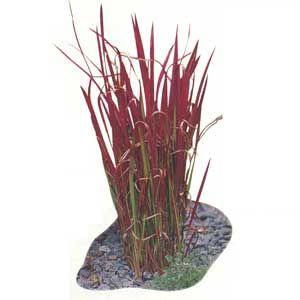
Ornamental Grass Planting and Care
The ideal time to plant ornamental grasses depends on your climate. In mild regions, you can plant in either spring or fall. However, if you live in a cold climate where temperatures drop to -20°F or lower, it’s best to plant in the spring. Follow these guidelines for successful planting:
- Remove existing sod and weed grasses from the planting area to prevent competition with your ornamental grasses.
- Space plants according to their mature height. For example, if a grass grows to 5 feet tall, plant it 5 feet from its neighbor, measuring from the center of one plant to the center of the next.
- Avoid adding fertilizer or amendments unless absolutely necessary, as excessive nutrients can lead to weak, floppy growth.
- Plant each grass at the same depth or slightly higher than it grew in its container to prevent water from collecting around the crown and causing rot.
- Water thoroughly after planting and apply an organic mulch, such as shredded bark or leaves, around the plants, keeping it away from the crown.
- Continue regular watering throughout the first growing season to establish strong root systems.
Prepare the planting area properly, as this will set the stage for healthy and vigorous growth. Thoroughly loosen the soil and amend it with organic matter if needed, checking for good drainage. When planting in large groups, create gentle mounds to enhance the visual impact and prevent waterlogging.
Ongoing Ornamental Grass Care
Once established, most ornamental grasses require minimal maintenance.
Annual Trimming
The primary care task is an annual trim in late winter or early spring. Cut grasses back to within 4 to 6 inches of the ground using pruning shears, electric hedge trimmers, or a power trimmer with a metal blade. Leaving this stubble helps protect the crown and emerging new growth from harsh weather conditions.
Dealing With Dead Centers
As grasses age, they may develop dead centers. When this happens, divide the plants to rejuvenate them. In early spring, dig up the entire clump and use a sharp knife or spade to slice it into smaller sections.
Replant the healthy outer portions and discard the dead center. For larger, clumping grasses, this process may require more effort and tools like an ax or hacksaw. Before dividing tall grasses, cut back the foliage by about a third to make handling easier. Always wear gloves and safety glasses to protect yourself from sharp grass blades during this process.
Use Mulch
Mulching around the base of the grasses can help retain moisture and prevent weed growth.
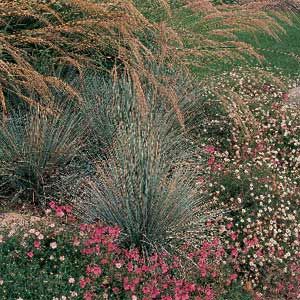
Grasses for Any Situation
There are ornamental grasses for almost any garden condition. Whether you need fall color, plants for wet areas, or screening solutions, there’s an ornamental grass that fits the bill.
For Outstanding Fall Color
These grasses turn attractive colors in the autumn, providing an additional season of interest:
- Broom-sedge (Andropogon virginicus, orange)
- Japanese blood grass (Imperata cylindrica ‘Red Baron,’ wine-red)
- Flame grass (Miscanthus ‘Purpurascens,’ orange-red)
- Switch grass (Panicum virgatum, golden-yellow)
- Red switch grass (Panicum virgatum ‘Hanse Herms,’ burgundy)
- Indian grass (Sorghastrum nutans, yellow-orange)
- Variegated prairie cord grass (Spartina pectinata ‘Aureomarginata,’ yellow)
- Japanese themeda (Themeda japonica, red-orange)
For a Wet Area
These grasses will thrive in wet or poorly drained soils:
- Sweet flag (Acorus calamus)
- Japanese sweet flag (Acorus gramineus)
- Feather reed grass (Calamagrostis acutiflora)
- Rushes (Juncus, all species)
- ‘Woods Dwarf’ dwarf ribbon grass (Phalaris arundinacea ‘Woods Dwarf’)
- Feesey’s form ribbon grass (Phalaris anundinacea ‘Feesey’s Form’)
- Variegated prairie cord grass (Spartina pectinata ‘Aureomarginata’)
For Screening
These grasses provide good height, dense foliage, and fast growth, making them excellent choices for screens:
- Karl Foerster’s feather reed grass (Calamagrostis acutiflora ‘Karl Foerster’)
- Compact pampas grass (Cortaderia selloana ‘Pumila’)
- Ravenna grass (Saccharum ravannae)
- ‘Cabaret’ miscanthus (Miscanthus sinensis condensatus ‘Cabaret’)
- ‘Morning Light’ miscanthus (Miscanthus sinensis ‘Morning Light’)
- Silver feather maiden grass (Miscanthus sinensis ‘Silberfeder’)
For a Dry Area
Once established, these grasses tolerate heat and drought:
- Broom-sedge (Andropogon virginicus)
- Side-oats grama (Bouteloua curtipendula)
- Blue grama (Bouteloua gracilis)
- Atlas fescue (Festuca mairei)
- June grass (Koeleria macrantha)
- Blue hair grass (Koeleria glauca)
- Switch grass (Panicum virgatum)
- Indian grass (Sorghastrum nutans)
- Prairie dropseed (Sporobolus heterolepis)
For Light Shade
While most grasses prefer full sun, these either tolerate or prefer light shade:
- Golden meadow foxtail (Alopecurus pratensis ‘Variegatus’)
- Sedges (most Carex species)
- Tufted hair grass (Deschampsia caespitosa)
- Hakone grass (Hakonechloa macra)
- Bottle-brush grass (Hystrix patula)
- Variegated moor grass (Molina caerulea ‘Variegata’)
- Autumn moor grass (Sesleria autumnalis)
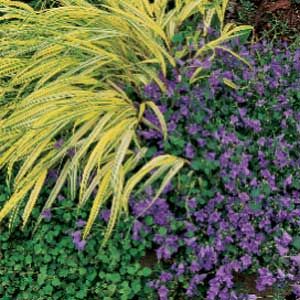
Our Conclusion
Ornamental grasses are versatile, low-maintenance plants that can transform any landscape with their unique textures, colors, and movement. From creating privacy screens to adding fall interest, these grasses offer solutions for various garden needs. When you plant the right grass for your needs and climate, you’ll enjoy the beauty and functionality of these plants for years to come.
